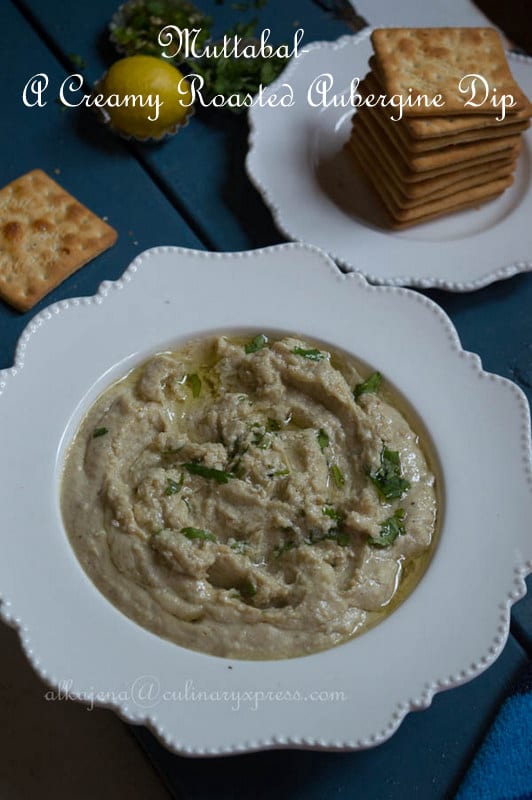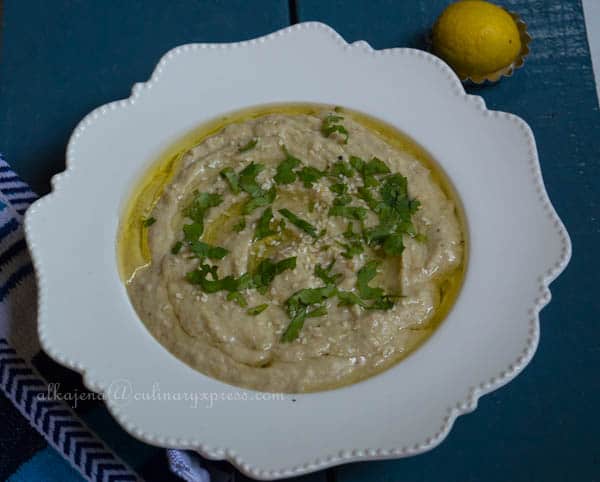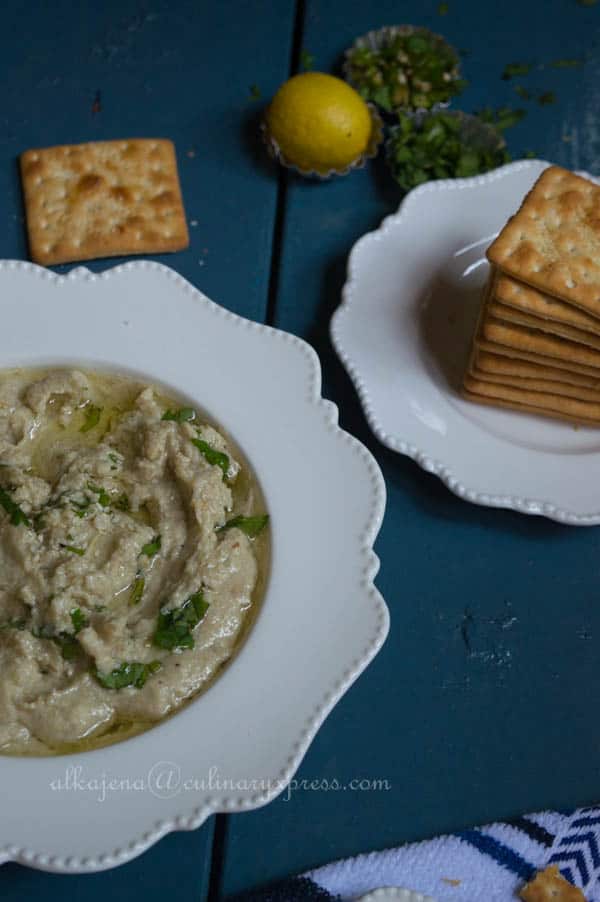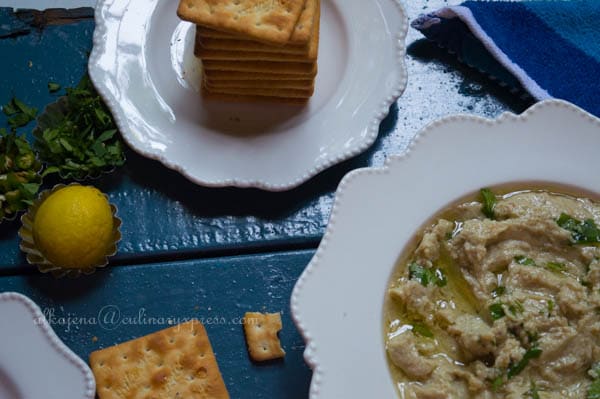
Middle Eastern cuisine is known for its massive selection of appetizers, referred to as “Mazze”. The different types of Mazze prepared by people from this region add to more than a hundred dishes. Some dishes are cold, others are hot, but all are a feast to the eye as they build up to form this colorful mosaic on the table. Mazze’s are customarily eaten dipped with warm pita bread. Usually, the main dish is preceded by a table full of Mazzes that people enjoy as they are having a drink and chatting together. This setting of happy chattering and sipping of drinks while nibbling on the mazzes can go for an hour or so before the main dish is served.

Muttabalis an extremely delicious Middle Eastern recipe I’m sure you’ll love! It is very nutritious, with a creamy taste due to the sesame paste (tahina) and yoghurt. Muttabal is mainly made from eggplants or Aubergine . Eggplant helps in reducing the risk of cancer and is effective for healing mouth ulcer, gastritis, pneumonia and arthritis. Spicy, with rustic flavor of garlic, the dip is served as mezze on pieces of pita.

[if !supportLineBreakNewLine]
[endif]
There’s a common misconception that is the same thing as Baba Ghanoush. In many restaurants, the two are used interchangeably on menus when in practice they are actually different dishes deriving from one main ingredient: roasted eggplant or Aubergine . As a result, both have a deep smoky taste that languishes on your tongue after each bite. While Muttabal and Baba Ghanoush are each found within the Levant region, their similarities end with the roasted eggplant and seasonings like lemon juice and garlic.

So after all of this what is the difference between the two? Both these dishes have the same main ingredient, smoky baked aubergine, but that where similarities end. Mutabal is the one with yogurt, Tahini and Garlic. Baba Ghanoush is the one with pomegranate molasses, tomatoes, parsley and walnuts.Aubergine for both dishes is traditionally cooked in an unorthodox way. You put the aubergine whole directly on open flame and you cook it till it is charred on the outside and soft on the inside. This gives the dish its characteristic smokiness. how to use a nectar collector

Foodie Monday Blog Hop theme is getting as interesting as it’s member Bloggers. This is an honest attempt on part of each and every Participating Blogger to cook as per the decided theme among the members each Week and share it on Monday. This week the Bloggers have decided to cook on the theme: Alphabetfood…doesnot it sounds interesting. Each and every Blogger has to choose an ingredient which correspondence to her name and cook a dish using the same ingredient. This weeks theme has been suggested by a talented Blogger Jolly Naidu, Food Blogger & SEO Professional who blogs at jollyhomemaderecipes.blogspot.in. Do check her website for some amazing collection of Cake recipes especially Whole Wheat Eggless Chocolate Cake, Rainbow Swirl cake, Orange Chiffon cake, Biscuit Cake to name a few.

As per this week’s Foodie Monday Blog Hop theme #Alphabetfood. I have decided to take up Aubergine as my ingredient as per the initial of my name #A. Aubergine with its near-black shiny-skinned exterior, is probably the most familiar comes in a wide variety of shapes, colours and sizes. Italian cooks enjoy varieties with long fruit and striking lavender and cream streaks. Asian varieties vary widely: some, such as the bitter-flavoured pea aubergine, are the size of a grape; the seed-filled, rounded Thai aubergine has green stripes and is used in curries; the beautifully long and slender pale-purple Japanese and Chinese varieties are ideal for stir-frying. The aubergine can also be ivory-colored, which almost certainly led people in some countries to name it the ‘eggplant’. I have decided make Muttabal which is a Middle eastern dish using the ingredient Aubergine.
Ingredients
Steps
- Salt – ½ tsp or as per taste

To garnish:
Ingredients
Steps
- Rub a bit of olive oil on the skin of the eggplants. Pierce them in a few places. Build a hot fire on a charcoal grill or set a gas grill to high. Grill the eggplants, turning and shuffling periodically until each side is blackened, and the flesh starts to collapse. Once cooked, transfer the eggplant to a bowl.
- When cool enough to handle, slit the skin of the eggplants skins with the tip of a knife (if not split already). Scrape the flesh into a fine mesh strainer, and season lightly with salt. Set aside over a bowl or sink while you get on with the onions.
- With the back of a spoon, gently press any remaining moisture out of the eggplant. Scrape the flesh into the bowl of a food processor with the metal blade attached. Add the onions, yogurt and lemon juice, tahini paste, garlic and then purée until smooth. Check for seasoning, adding more yogurt, lemon or salt as needed. If you feel you want it a little creamier and eggplant-garlic taste is a bit too strong, add Greek yogurt, sour cream and blend well.
- Spread nicely in a plate in such a way that you form a pit in the center that is not too deep. Garnish with coriander leaves and top with olive oil and sprinkle chopped green chillies. Serve with Cream cracker, grilled Naan or Pita Bread.

Note: The eggplant needs to be as dry as possible for a thicker spread. Add some cooked chickpeas to the processor until the desired consistency is reached. For a richer spread, replace the yogurt with the same amount of natural cashew butter.


Comments are closed.